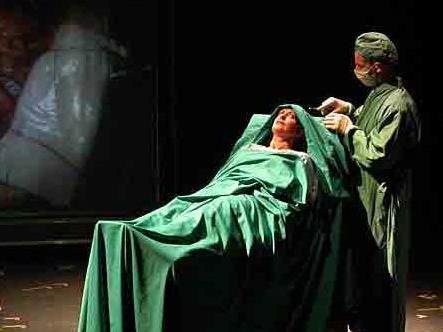Lipsynch at Arts Centre Melbourne: an ailing venue
On Friday, the Chairman of Arts Centre Melbourne announced the resignation of Chief Executive, Judith Isherwood. It seemed to have all the hallmarks of a well-managed media strategy with the announcement hitting the streets late on Friday afternoon as Melbournians headed for their favourite bars to celebrate the end of the Spring Carnival.
In the wake of the losses recently announced and significant retrenchments, the statement said that Arts Centre Melbourne would continue to pursue the programming strategy defined by Isherwood and spoke fulsomely of her contribution.
Confused? You are not alone.
Isherwood was quoted in The Age in February this year as proclaiming the refurbished venue would, ‘play in the same league as other greats, like London’s Barbican … and New York’s Lincoln Centre’. The program was acknowledged as unprecedented. Isherwood, again in The Age – ‘We’re proactive. We’re moving to a more curatorial approach, a bit like festivals.’
The Trust’s announcement seems to be saying that this “festival strategy” for Arts Centre Melbourne was right; it was only the execution that was to blame for the losses.
A number of people have lost their jobs on that basis with the deepest cuts being made in the programming areas of the company.
The Arts Centre’s accounts show just how unsuccessful the strategy was in 2013.
The Arts Centre took on significant additional programming costs from the time Isherwood assumed the CEO’s position as the venue switched into festival-like programming from the traditional venue-for-hire approach.
It opened the war-chest to promote the re-opening of Hamer Hall, the concerts venue in the St Kilda Road complex, after it was closed (mid-2010 to mid-2013) for a $136 million re-fit.
Arts Centre Melbourne
Selected Costs
ACM’s costs ramped up over 3 years prior to the opening of Hamer Hall with programming and publicity ballooning in the opening year. (ACM Annual Reports, Selected costs, 2007-2013)
Total annual costs in 2013 at $84.6 million were $33.0 million above 2009 levels while revenues at $77.4 million, were $23.9 million greater.
In the programming function, directly related to the implementation of the strategy, direct costs in 2013 were $15.9 million, $7.4 million above the 2009 levels and $5.3 million (50%) above the prior year. In addition, publicity costs doubled to $4.4 million during Isherwood’s tenure at Arts Centre Melbourne.
Such expenditure was necessary to support a program of the magnitude implied by the bold programming strategy.
On the income side, operational revenues in 2013 were $77 million (including the government grants of $19 million). This represented an increase of approximately $21 million. Of this, however, $10.3 million was derived from bringing catering in-house. This proved to be a contentious move as costs of providing this service marginally exceeded revenues so it returned a loss.
Key Revenue Items
ACM’s revenues jumped in 2013 after the refurbishment shut-down of Hamer Hall in 2010.
(ACM Annual Reports, 2007-2013)
Most importantly, income from sales of Arts Centre-curated programs stood at $8.7 million, little more than half of the direct cost. They contributed only $2.8 million of the increase in revenues for the year, with each extra programming and publicity dollar in 2013 generating around 50 cents in new programming revenue.
Programming Income vs Expenditure
ACM’s programming revenues didn’t match the increase in expenditures.
(ACM Annual Reports, 2007-2013)
In the light of these unflattering figures, it’s worth asking if the festival-like programming strategy can still be justified.
London and New York are cities with populations several times larger than that of Melbourne, densely-settled and situated at the crossroads of international tourist trails. The costs of staging comparable artistic companies and performers in Melbourne are considerably greater due to the distance involved and the difficulty in attracting artists away from their core markets.
But do Melbournians expect festival-like productions from their regular arts presenters? I attended a 9-hour-long performance of Lipsynch in the 2085-seat State Theatre and everyone else in attendance was within earshot of my seat.
The momentum of a festival carries with it an audience of people seeking new experiences and wanting to expose themselves to performances they normally might not.
Festivals are subsidised partly for this reason and partly because the spin-offs for government are tangible due to concentrated tourist promotion and increased economic activity. It’s questionable whether any of this applies to a regular arts centre program.
Where was the rationale for a year-long festival, the key initial months of which occurred just prior to the annual Melbourne International Festival?
According to the media release announcing Isherwood’s departure, however, the Trustees remain committed to this strategy.
Arts Centre Melbourne’s website still proclaims, ‘2013 is set to be an heroic year’. For financial types, the use of the word ‘heroic’ sets off alarm bells. It might be that it was intended to refer to the flavour of the season but the warning sign is in the scale and adventure that the word also implies and the possible disregard for risk.
One has to be bold in the arts, most people would accept. Any arts company that attempts to build a large audience without bringing in big-name attractions for audiences faces a losing battle. But the skill is to be both artistically bold and financially secure. No-one wants to see a Costa Concordia of the arts in Melbourne.
As the Arts Centre is underwritten by the government, it is to be hoped that the shareholders’ representative, Arts Victoria, has taken on improved capabilities to review and assess the likely commercial viability of this sort of programming in the future. With a more holistic perspective, it should ensure that Victorians are spending their total arts budget, including that on the Melbourne International Festival and the Arts Centre, in a complementary manner without yielding to organisational hubris.





